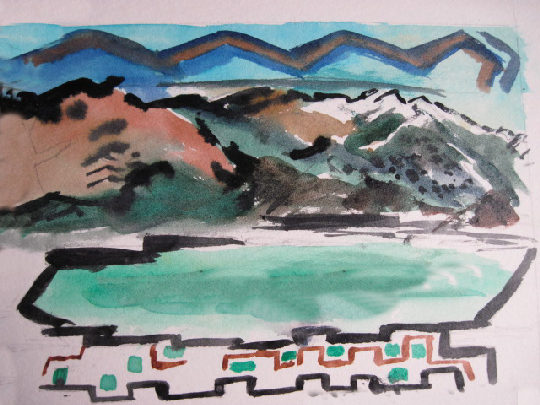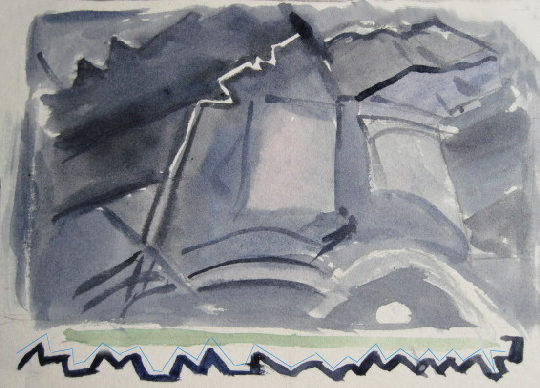Recently I was fortunate to view 46 originals by artist John Marin at the
Art Institute of Chicago with
Creative Artists, a fun group of artists. As always, the Art Institute provided an extremely informative exhibition. I have been asked to share my notes.
John Marin: Part 1 will be my first impressions and observations of Marin’s artwork.
John Marin: Part 2 will reveal more of my findings as I continue to study his work. For though I seek not to paint in John Marin’s style, in my experience as an artist, I acknowledge that I can learn much from his method of reasoning.
John Marin: Part 1
America’s No. 1 Artist
The Look Magazine, in its February 1948 issue, named John Marin as “America’s No. 1 artist.” Throughout his lifetime, this honor was constant, because he manipulated his tools into harvesting kinetic energy with bold colored marks. His reasoning was “Using paint as paint is different from using paint to paint a picture… Although I use objects, I am representing paint first of all and not the motif primarily.”
My first two observations about Marin’s work were his drab colors and his framing device by which he created a visual frame directly on the art piece itself. Although the drab colors could relate to the regions where Marin painted, I have seen gorgeous color in other artists’ artwork of these same regions.
About the visual frame, on some pieces, Marin used staccato strokes that interacted with the overall look of the piece. One example is his painting New Mexico 1930.
The following photo is my rendition of his New Mexico 1930.
The zigzag lines on the top interplay with the natural mountain forms.
The lower staccato lines resemble the village dwellings and the zigzag patterns
of decoration found on indigenous pottery from the Southwest.
Marin also used the frame device to set the mood, such as in his painting
Storm, Taos Mountain, New Mexico 1930.
The following photo is my rendition of this painting.
The lower patterned border motifs appear in static as the storm rages.
Marin also used this border on his artwork when painting waves off the Maine coast.
Kinetic Energy
It has been said that Marin was well known for harvesting kinetic energy. Kinetic energy comprises the unseen forces of movement, weight, and balance. Often in Marin’s paintings, the opposing forces of mountains and sea are demonstrative, and this opposing force resounds with the rolling and shifting movement of the ocean under the schooners he painted. This reinforces his quote “To paint disorder under a big order.” Marin explained, “Feeling is important. I feel the sea.” In addition, he stated, “While these powers are at work pushing, pulling, sideways, downwards, upwards, I can hear the sound of their strife and there is great music being played.”
Marin’s Symbols
Eventually the schooner motif became Marin’s personal talisman and he incorporated it into many of his works. Other symbols were present in his work, such as the Maine pines, which became an iconic symbol of survival in a harsh world, as portrayed in his painting, The Tree, Bare Island, Maine, 1922. Marin’s triangles in his artwork related the forces that connect the big elements of nature. As Marin knew, diagonals emit energy.
Marin’s Techniques
Marin used dry brushstrokes for the water’s textures, with intervals of wet into wet. Striking the paper, he superimposed a structure of emphatic horizontal, vertical, and diagonal lines with a wide brush and blue watercolor in his painting, Blue Sea 1923. His amorphous washes suggested formations of rocks with pale blue tints for foam. Marin painted multiple shades of black, blue, and green to appear as depth and movements below the waves. He often used paint directly from the tube onto his paper, and then would wipe away the paint to create softness. “You must be made to see that artist’s scene and not nature’s scene,“ Marin pointed out.
Marin stressed, “Fewer strokes, fewer strokes, fewer strokes must count.” He insisted that one paint the essential forms only by using lines and colors. “Seems to me that the true artist must perforce go from time to time to the elemental big forms,” Marin related. The big forms in his paintings included the sky, sea, mountains, plains, and buildings.
I, a studio artist, will close this John Marin: Part 1 with a chuckle about his quote on studio painting. Marin’s quote, “It is dangerous ever, ever to work in a studio… Nature’s arrangements are much finer… But that don’t mean you cannot use these great natural foundlings and juggle and mold and play to your heart’s content. “
Fellow Artists, I can openly avow that I am definitely playing and painting
to my heart’s content in my studio and having a ball!
Posted on April 20, 2011.

